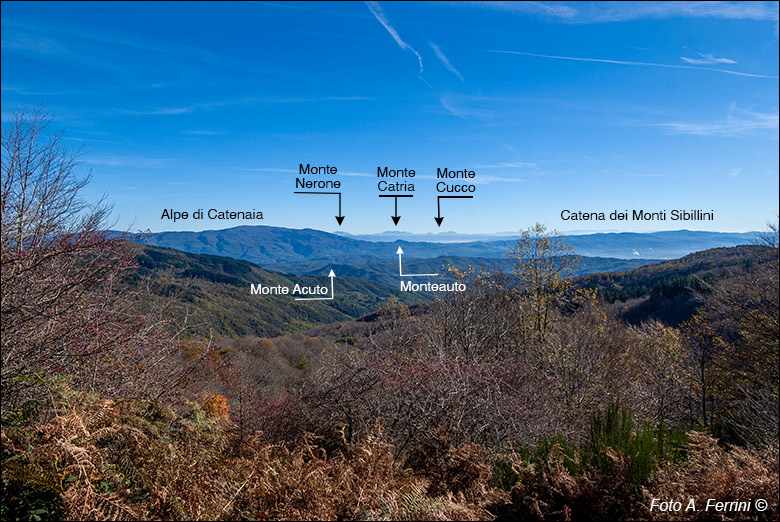Dal Varco di Anciolina a Badia Santa Trinita
itinerario da Pontenano all'abbazia benedettina di Santa Trinita e al Varco di Anciolina
Italiano
NATURA E STORIA PRESSO BADIA SANTA TRINITA 5
Centocinquanta metri dopo la sbarra inizia un tratto di trecentocinquanta metri del CAI 32 molto panoramico. La vista verso sud-est è ampia e molto interessante. Vediamo la valle del Torrente Capraia che scende verso Talla. Monte Acuto si trova tra questo paese e Salutio, sulla sua cima ci sono i ruderi di un castello che controllava un vasto territorio. Fu distrutto nel 1502 da Vitellozzo Vitelli, Signore di Città di Castello, con l'intento di far danno a Firenze.
A sinistra l'orizzonte è segnato dall'Alpe di Catenaia, nella parte discendente di questa montagna si distingue bene Monteauto dove si trova l'omonimo castello dei Conti Barbolani. Il Conte Alberto è noto per il rapporto di amicizia che ebbe con San Francesco.
Dietro, in lontananza, distinguiamo il Monte Nerone, il Monte Catria e il Monte Cucco, rilievi posti tra Umbria e Marche. Più a destra, meno visibile, c'è la catena dei Monti Sibillini.
Torniamo molto vicino a noi, ai nostri piedi. La zona che discende, davanti a noi, è segnata nelle mappe catastali Badia Vecchia o Badivecchia. Un toponimo molto interessante perché il manoscritto che narra della fondazione di Badia Santa Trinita dice che l'attuale sito non fu quello che vide l'origine dell'importante abbazia benedettina. Detto ciò è logico supporre che il primo sito di Santa Trinita si trovasse in questa zona detta Badia Vecchia.
Fino agli anni Cinquanta del Novecento Badivecchia era completamente spoglia di boschi e per secoli è stata un grande pascolo utilizzato per lo più dai pastori di Pontenano. Ho fatto vari sopralluoghi e ricerche in questa zona, tra cespugli, felci e rovi ho trovato chiare testimonianze di antropizzazione. Tracce di un edificio e poi alcune grosse pietre squadrate e scalpellate. Ben poco per testimoniare la presenza di una badia, ma è anche vero che i pastori non si cimentavano in questi lavori. A che scopo? Qui si trova anche una storica sorgente ricordata da sempre. Elemento fondamentate per il sorgere di qualunque cosa che prevedesse la presenza umana.
Osservato il panorama, riprendiamo il nostro cammino. Tra pochi minuti ci aspetta qualcosa di molto interessante.
One hundred and fifty meters after the barrier begins a three hundred and fifty meter stretch of the CAI 32 very panoramic. The view towards the south-east is wide and very interesting. We see the valley of the Capraia torrent that descends towards Talla. Monte Acuto is located between this town and Salutio, on its summit there are the ruins of a castle that controlled a vast territory. It was destroyed in 1502 by Vitellozzo Vitelli, Lord of Città di Castello, with the intent of causing damage to Florence.
On the left the horizon is marked by the Alpe di Catenaia, on the descending part of this mountain you can clearly see Monteauto where the castle of the same name of the Counts Barbolani is located. Count Alberto is known for the friendship he had with Saint Francis.
Behind, in the distance, we can distinguish Monte Nerone, Monte Catria and Monte Cucco, reliefs located between Umbria and Marche. Further to the right, less visible, there is the chain of the Sibillini Mountains.
Let's get back very close to us, to our feet. The area that descends, in front of us, is marked on the cadastral maps Badia Vecchia or Badivecchia. A very interesting toponym because the manuscript that tells of the foundation of Badia Santa Trinita says that the current site was not the one that saw the origin of the important Benedictine abbey. That said, it is logical to assume that the first site of Santa Trinita was located in this area called Badia Vecchia.
Until the 1950s Badivecchia was completely bare of woods and for centuries it was a large pasture used mostly by the shepherds of Pontenano. I have done various inspections and research in this area, among bushes, ferns and brambles I have found clear evidence of anthropization. Traces of a building and then some large squared and chiselled stones. Very little to testify to the presence of an abbey, but it is also true that the shepherds did not try their hand at these works. For what purpose? Here there is also a historical spring that has always been remembered. A fundamental element for the birth of anything that involved human presence.
After observing the panorama, we continue our journey. In a few minutes something very interesting awaits us.























































































